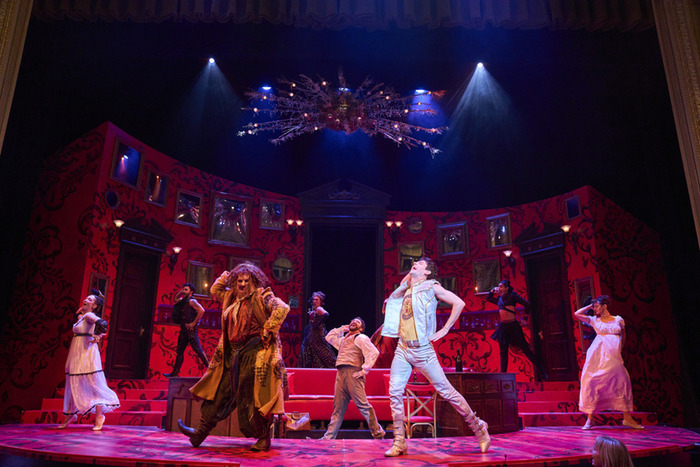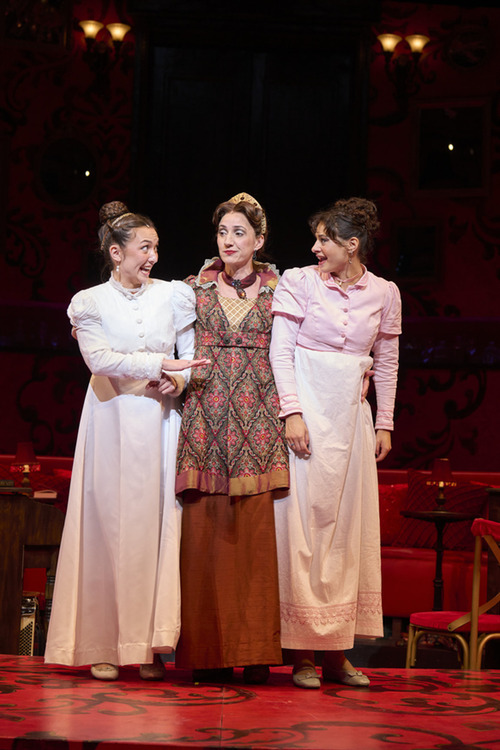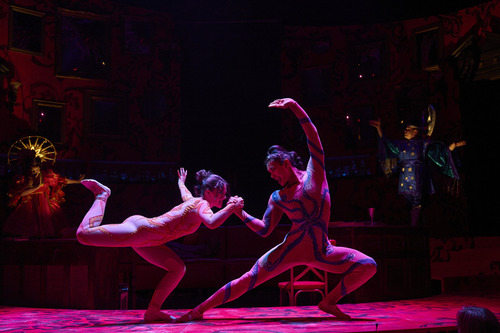
When I saw the show in its Broadway run, I wrote in my review, “The total effect of Natasha, Pierre & the Great Comet of 1812 is breathtaking. The traditional music, dress, stylized acting and Josh Groban’s booming voice add to the overarching effect. Yes, this is more than a musical, it is a spectacle of enormous proportions.”
There is no Josh Groban on stage at Great Lakes Theater, where the show is now running, but my rave comments are the same for the local Vicki Bussert-directed creative spectacular.
As the tale goes, in the nineteenth century, a comet officially known as C/1811 F1 was visible to the naked eye for a record 260 days. The huge spatial phenomena, which is often called the Comet of 1812, became a fascination for artists and writers who painted it and wrote stories with it as the focus. One of the best-known literature usage was in Leo Tolstoy’s epic War and Peace.
In the novel, Tolstoy describes Pierre observing this “enormous and brilliant comet.” He went on to indicate it “was said to portend all kinds of woes and the end of the world.” From the standpoint of the Russians, the prognostication became true as the invasion of Russia by Napoleon (Patriotic War of 1812) took place.
C1811 F1 has appeared again. This time it is justifiably shaking up Playhouse Square. (It is ironic that the famous CLE theatre mecca introduced its new electronic theater marques and enhanced lighting displays during the run of this show.)
The bold, imaginative electropop opera is from award-winning composer (and Lakewood, OH native!) Dave Malloy. When asked why the comet made it into the title of the show, Malloy stated, “for cosmic epicness.”
Yes, the show is proving itself to be an epic as evidenced by the fact that it became the most Tony-nominated show of the 2017 season, garnering 12 recognitions including that for best score, book and orchestration, as well as best direction, choreography, actor, actress, featured actor, scenic, costume and lighting design.

The power and grandeur of the show hits the audience upon entering the theater though the Hanna was not totally redone, as was the Imperial theater on Broadway when it was totally transposed for the production. The proscenium stage was replaced by a raked series of platforms that extended to the theater’s back wall and ceiling.
Weaving staircases allowed the actors to wander from one level to another, attendees were seated in nooks and crannies on stage, and musicians were placed in varying places, including a depressed circle in the middle of the stage area which contained a grand piano. (Seated on stage, I was upclose and personal with Josh Groban and numerous actors in several scenes.)
The entire theater became a performance space as the orchestra, mezzanine and balcony had platforms and seats that allowed for performance pieces to be done immediately next to audience members. The theater’s walls had been draped with heavy maroon material, with varying antique framed photos and decorative art pieces hung on them. It was as if one was in a grand Russian villa of old.
Not to be outdone, the local production has a huge red-flocked backwall, table seating on the edge of the thrust stage, empty seats in the orchestra area of the theater, into which actors flop and sit and talk to their seat neighbors. Actors cavort up and down the aisles and appear in the side boxes. The whole theatre is their playground.
Malloy’s well-written music combines traditionally played ethnic, folk, classical, and indie rock with EDM. The sound of accordions, violins, tambourines, balalaika and wood blocks, as well as piano and synthesizer, give the score a unique, not often heard, musical theater sound.
Don’t be surprised if you are sitting in the front rows when an actor hands you a pair of shakers and teaches you how to use them at appropriate segments of the show. If you ever wanted to appear in a live stage show, here is your chance! “Nostrovia!”
Malloy’s book and lyrics, like Russian literature, is filled with great angst, exaggerated emotion and melodrama. Wisely, the author has avoided the Russian tradition of each person having numerous full names plus diminutives. But you still may get lost in the singing narrative.
As a friend said after seeing the show, as with reading Russian literature, you need to be exposed to the material at least twice to really understand it.
The tale is set in Moscow in 1812. Pierre (Alex Syiek) a middle-aged aristocrat, is living an existential life, often influenced by an overabundance of vodka. Into his sphere of life comes Natasha (Jessi Kirtley), a beautiful young lady, who is visiting the Russian capital, while her fiancé, Andrey (Cole Burden) is at war. She is seduced by Anatole (Chris McCarrell), an attractive and manipulative married man. Her social standing is ruined. Her only hope lies with Pierre using his influence to save her reputation.

As can be expected in a Russian saga, Pierre dramatically helps Natasha gain her sense of self. Afterwards, almost as a payment for his good deed, he experiences a moment of enlightenment as he sees the Comet of 1812 in the night sky.
The physical setting is impressive, even though I would have liked a more vividly exciting comet. The musical presentation was grand; The vocalizations, compelling; The stylized acting, character correct.
The Baldwin Wallace Music Theatre grads and present students, who inhabit most roles, have voices that one would expect from the uber-talented performers, trained in one of the nation’s finest musical theater programs.
Cleveland Critics Circle award0winning actor Syiek (The Hunchback of Notre Dame, 2017 at Great LakesTheater) is powerful in his Pierre. His aria “Dust and Ashes” captivates. His duet “Pierre & Anatole,” with Chris McCarrell, is compelling as is his “Pierre & Natasha,” a duet with Jessi Kirtley.
The beautiful Kirtley is charming as Natasha who not only sings well, but creates a vulnerable young woman who is charmed into a seduction by the uber-talented and multi-Broadway leading man, Chris McCarrell, the evil villain, who takes away Natasha’s innocence. He moves with arrogant ease, smiling with manipulative pleasure, while displaying no remorse.
The rest of the cast is talented and never wavering in their character involvement, a tribute not only Bussert, the director, but “Vicky,” the mother-superior of the BW music theatre program, and her staff.
Matthew Webb leads the perfectly tuned musicians. Jeff Hermann creates the impressive setting, Tesia Dugan Benson’s era-right costumes glisten, Trad A Burns has created a sumptuous lighting design and Jaclyn Miller’s choreography is glorious.

Capsule judgement: When I reviewed the Broadway production of NP&TGC1812 I said it was “breathtaking.” I continued, “This is more than a musical, it is a spectacle of enormous proportions.” I repeat the same for the GLT production and add that I doubt if there is another director on the local scene who could create such a quality staging of this script!
For tickets to GLT shows go to greatlakestheater.org/or call (216) 241-6000.
[Written by Roy Berko, member: American Critics Association, Cleveland Critics Circle]